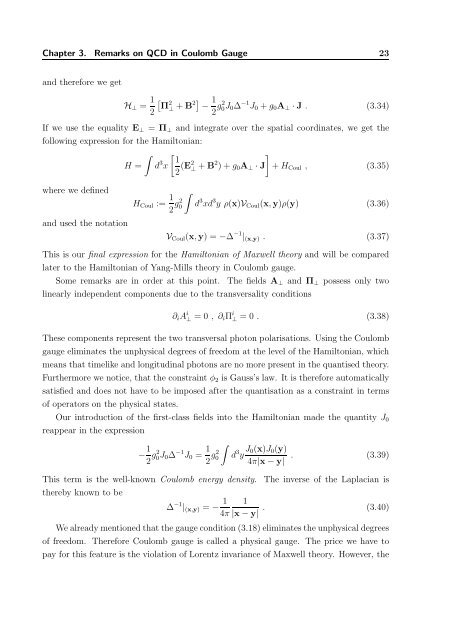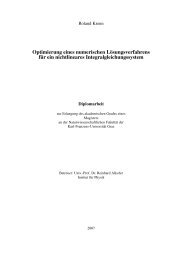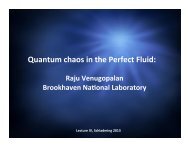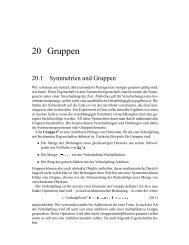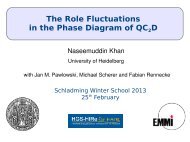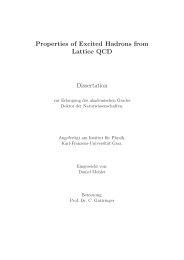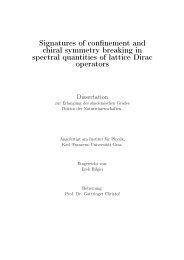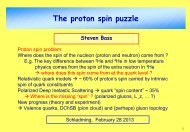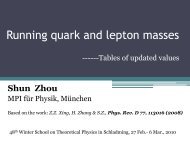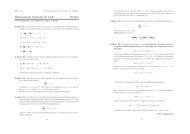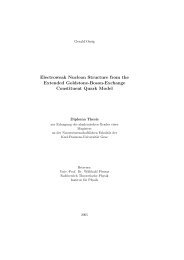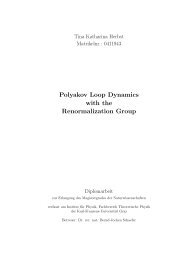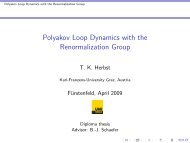The QCD Quark Propagator in Coulomb Gauge and - Institut für Physik
The QCD Quark Propagator in Coulomb Gauge and - Institut für Physik
The QCD Quark Propagator in Coulomb Gauge and - Institut für Physik
You also want an ePaper? Increase the reach of your titles
YUMPU automatically turns print PDFs into web optimized ePapers that Google loves.
Chapter 3. Remarks on <strong>QCD</strong> <strong>in</strong> <strong>Coulomb</strong> <strong>Gauge</strong> 23<br />
<strong>and</strong> therefore we get<br />
H ⊥ = 1 [<br />
Π<br />
2<br />
2 ⊥ + B 2] − 1 2 g2 0 J 0∆ −1 J 0 + g 0 A ⊥ · J . (3.34)<br />
If we use the equality E ⊥ = Π ⊥ <strong>and</strong> <strong>in</strong>tegrate over the spatial coord<strong>in</strong>ates, we get the<br />
follow<strong>in</strong>g expression for the Hamiltonian:<br />
∫ [ ]<br />
1<br />
H = d 3 x<br />
2 (E2 ⊥ + B2 ) + g 0 A ⊥ · J + H Coul , (3.35)<br />
where we def<strong>in</strong>ed<br />
H Coul := 1 2 g2 0<br />
∫<br />
d 3 xd 3 y ρ(x)V Coul (x,y)ρ(y) (3.36)<br />
<strong>and</strong> used the notation<br />
V Coul (x,y) = −∆ −1 | (x,y) . (3.37)<br />
This is our f<strong>in</strong>al expression for the Hamiltonian of Maxwell theory <strong>and</strong> will be compared<br />
later to the Hamiltonian of Yang-Mills theory <strong>in</strong> <strong>Coulomb</strong> gauge.<br />
Some remarks are <strong>in</strong> order at this po<strong>in</strong>t. <strong>The</strong> fields A ⊥ <strong>and</strong> Π ⊥ possess only two<br />
l<strong>in</strong>early <strong>in</strong>dependent components due to the transversality conditions<br />
∂ i A i ⊥ = 0 , ∂ i Π i ⊥ = 0 . (3.38)<br />
<strong>The</strong>se components represent the two transversal photon polarisations. Us<strong>in</strong>g the <strong>Coulomb</strong><br />
gauge elim<strong>in</strong>ates the unphysical degrees of freedom at the level of the Hamiltonian, which<br />
means that timelike <strong>and</strong> longitud<strong>in</strong>al photons are no more present <strong>in</strong> the quantised theory.<br />
Furthermore we notice, that the constra<strong>in</strong>t φ 2 is Gauss’s law. It is therefore automatically<br />
satisfied <strong>and</strong> does not have to be imposed after the quantisation as a constra<strong>in</strong>t <strong>in</strong> terms<br />
of operators on the physical states.<br />
Our <strong>in</strong>troduction of the first-class fields <strong>in</strong>to the Hamiltonian made the quantity J 0<br />
reappear <strong>in</strong> the expression<br />
− 1 2 g2 0 J 0∆ −1 J 0 = 1 ∫<br />
2 g2 0 d 3 y J 0(x)J 0 (y)<br />
. (3.39)<br />
4π|x − y|<br />
This term is the well-known <strong>Coulomb</strong> energy density. <strong>The</strong> <strong>in</strong>verse of the Laplacian is<br />
thereby known to be<br />
∆ −1 | (x,y) = − 1 1<br />
4π |x − y| . (3.40)<br />
We already mentioned that the gauge condition (3.18) elim<strong>in</strong>ates the unphysical degrees<br />
of freedom. <strong>The</strong>refore <strong>Coulomb</strong> gauge is called a physical gauge. <strong>The</strong> price we have to<br />
pay for this feature is the violation of Lorentz <strong>in</strong>variance of Maxwell theory. However, the


